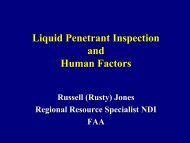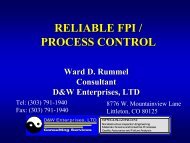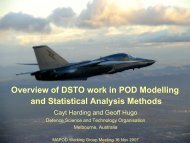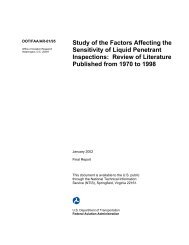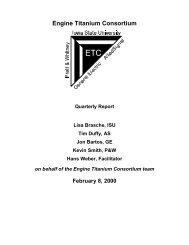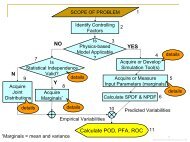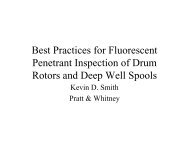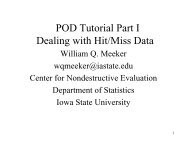Engine Titanium Consortium - Center for Nondestructive Evaluation ...
Engine Titanium Consortium - Center for Nondestructive Evaluation ...
Engine Titanium Consortium - Center for Nondestructive Evaluation ...
Create successful ePaper yourself
Turn your PDF publications into a flip-book with our unique Google optimized e-Paper software.
A report documenting the relative effectiveness of conventional and Multizone systems <strong>for</strong> the<br />
ultrasonic inspection of billet.<br />
Revised estimates of POD <strong>for</strong> larger diameter titanium billet (10″ to 14″).<br />
POD and PFA estimates <strong>for</strong> nickel billet, including comparison with POD results from existent<br />
methodologies.<br />
Estimates of POD and PFA <strong>for</strong> titanium billet based on use of the random defect block, CBS data,<br />
and data reported to JETQC, including comparison with POD results from existent methodologies.<br />
Metrics:<br />
A procedure <strong>for</strong> incorporating the properties of naturally-occurring defects into a model-based POD<br />
methodology will have been defined in a <strong>for</strong>mal report which becomes the basis <strong>for</strong> industrial<br />
practice, providing a consistent basis <strong>for</strong> future implementation of the POD methodology.<br />
The success of the new POD methodology developed in Phase I will be critically reviewed in terms<br />
of attainment of the original goals, using the following criteria:<br />
• POD results are more accurate than those of existing methodologies. They should be close<br />
(e.g., flaw size <strong>for</strong> a given probability within ±40%) to those from existing (R e and â-versus-a)<br />
methods when the requirements of those methods are satisfied and provide sensible<br />
predictions in cases in which the existing methods cannot produce answers.<br />
• PFA results are estimated as a function of threshold and these estimates are validated by<br />
independent experiments.<br />
• The method provides a means to predict the effect on POD and PFA of changing (as a<br />
minimum) transducer beam properties (diameter, focal length, water path, beam orientation);<br />
transducer frequency; scan index; flaw properties (location, dimensions, acoustic impedance,<br />
orientation relative to the sound beam); material properties (acoustic impedance,<br />
grain-boundary noise), with experimental validation that the response agrees with that predicted<br />
by the model, as a result of changing any one of these parameters, within accuracies typical of<br />
ultrasonic measurement, i.e., about ±3 dB (or ±40%).<br />
Modifications will be developed that will enhance the speed, simplicity of use, and range of<br />
applicability of the POD software developed in Phase I; the ease of operation will be demonstrated<br />
by successful transfer of the software to one or more OEMs.<br />
Estimates of the POD of hard-alpha defects in titanium billets will be extended to cover billet<br />
diameters up to 14″. Success of this enhanced capability <strong>for</strong> assessing the quality of one of the<br />
materials used in manufacture of aircraft engines will be indicated by incorporation of these<br />
estimates in life management calculations by the FAA, members of ETC and the Rotor Integrity<br />
Subcommittee of AIA.<br />
Estimates of the POD of hard-alpha defects in titanium billets, and of white spots in nickel billets,<br />
will be updated periodically. Success will be indicated by incorporation of these estimates in life<br />
management calculations by the FAA, members of ETC, and the Rotor Integrity Subcommittee of<br />
AIA.<br />
Quarterly Report – January 1, 2002 –March 31, 2002<br />
print date/time: 6/6/2002 - 8:39 AM – Page 96



